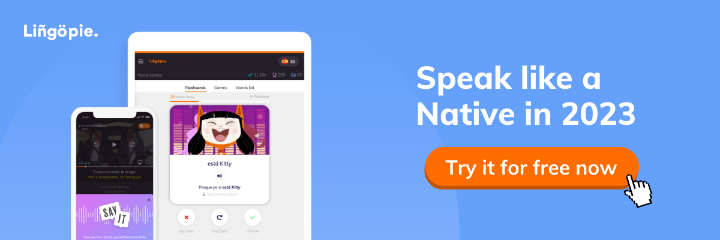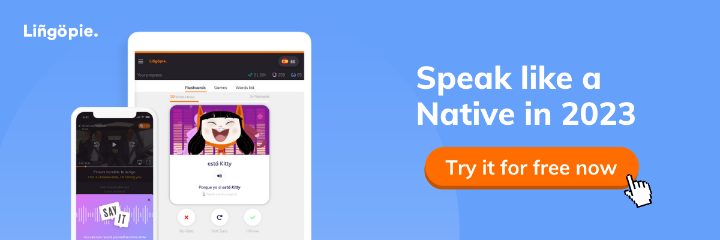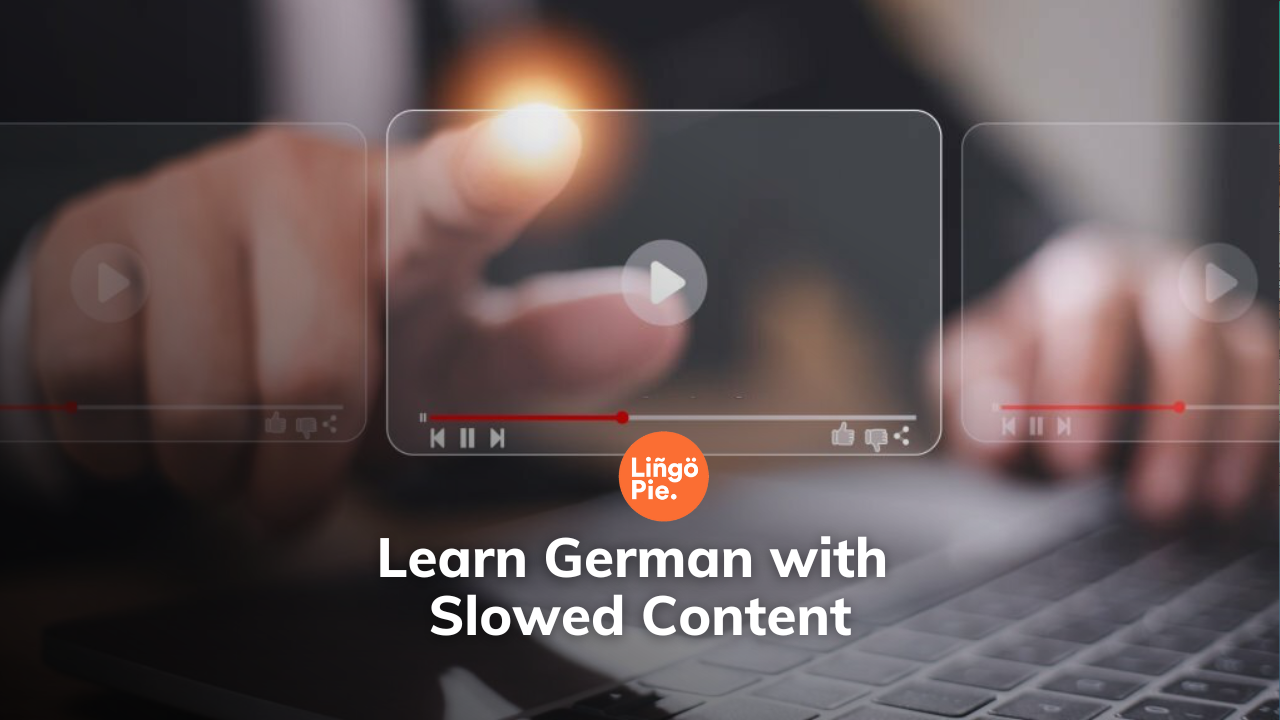Whilst it's a catchy song, harder, better, faster, stronger does not apply when learning a new language. Especially one as tricky as German.
Of course, we're not trying to discourage you from learning German. Quite the opposite, but this language will require a bit more time and dedication than others, such as Spanish.
A "slow content" approach can be effective for learning a language like German because it encourages in-depth and immersive language exposure. In this post, we'll explain exactly what the "slow content" approach is, and how you can use it to your advantage.
This form of language learning is most beneficial for beginners, given that advanced learners do not require slower content. For beginners, it can be extremely beneficial.
Now, let's see what slowed content actually is. We'll start with the basics.

Table of contents
- What is Slowed Content in the Context of German Language Learning?
- How to Use Slowed Content
- Where to Find Slowed Content
- The Benefits of Slow German
- Lingopie is Our Top Pick For Slow Learning
- When to Stop Using Slowed Content
- FAQs
- Summing Up: How to Learn German with Slow Content
What is Slowed Content in the Context of German Language Learning?

"Slowed Content" is a deliberate approach to content creation, emphasizing quality and depth over speed. It's particularly relevant for language learning, including German.
By consuming "slow news" in German, learners can improve their language skills, comprehension, and fluency. This method is effective because it provides exposure to authentic language use at a manageable pace.
Furthermore, it aids in the language learning process by allowing learners to dissect and understand German grammar and idiomatic expressions, ultimately helping them speak German fluently.
Listening to native German speakers in this way is sure to facilitate learning, particularly listening comprehension. This contributes to a richer understanding of the German-speaking world and culture for learners.
How to Use Slowed Content
Utilizing slowed content for learning the German language can be highly effective. Seek out native German speakers or educational platforms that provide slowed German content, such as podcasts, videos, and specific German courses.
This content often includes valuable German phrases and idioms spoken at a manageable pace. In addition, incorporate these resources into your German lessons to enhance your comprehension, vocabulary, and pronunciation.
Slow content allows you to dissect and understand the nuances of the language, making it easier to grasp German idioms and cultural context.
When you learn German, you should engage on a regular basis with such content to strengthen your language skills and build confidence in your German communication.
Where to Find Slowed Content
Various online resources and platforms are catering to learners of different languages, including German.
Whether you want to enhance your comprehension as a beginner, focus on literal meanings, or improve your speaking skills, you have a plethora of options at your fingertips. Here are our top picks:
1. Spotify

Spotify provides access to playlists filled with German songs and audio books. This platform allows learners to delve into lyrical nuances, grasp cultural contexts, and improve their listening skills.
Music can be a delightful and immersive way to learn a language, as it combines enjoyment with education. Spotify is also a great place to find free German podcasts.
2. Lingopie

If you haven't heard of Lingopie yet, where have you been? This platform offers a substantial library of native language content, including movies, TV shows, and music.
Lingopie's playback feature enables learners to slow down the pace of the content, which is an excellent tool for beginner and intermediate learners.
This feature, amongst several others, makes the platform a valuable tool for anybody that wants to refine their German pronunciation and practice listening comprehension.
It's like having a personal language tutor, guiding you through authentic content at your own pace.
3. YouTube
In addition to the platforms mentioned above, YouTube also hosts a wealth of slow German content.
From instructional videos to language lessons and conversations in slowed-down German, it is a valuable source for learners aiming to enhance their pronunciation and comprehension.
With YouTube's vast and diverse content, you can explore various aspects of the German language and culture.
Related:
The Benefits of Slow German
Learning the German language through a "slow" approach offers several significant benefits, which we highlight below.
Deep Comprehension
Slower content allows learners like you to understand the German language's nuances, grammar, and structure.
Furthermore, you will get a profound understanding of idiomatic expressions and cultural context, paving the way for effective communication.
Improved Pronunciation
The deliberate pace of slow content aids in perfecting pronunciation. This is due to the fact that learners can mimic native speakers more accurately, leading to clearer and more authentic communication.
With Lingopie, you can perfect your pronunciation by repeating the content you hear.
Enhanced Retention
The deliberate, unhurried "slow content" approach helps learners absorb and remember new words and phrases better. This promotes long-term retention and reinforces language skills.
Cultural Insight
In addition to the above benefits, slower content often delves into cultural aspects, enabling learners to gain a richer understanding of German culture, history, and daily life.
This, in turn, promotes cultural sensitivity and more profound engagement with native speakers.
Confidence and Fluency
With in-depth comprehension, improved pronunciation, and cultural awareness, learners like you can gain confidence and eventually achieve fluency in the German language.
This confidence makes real-world communication more comfortable and enjoyable when you talk to native speakers in Germany and beyond.
The benefits of learning German through a "slow" approach are multifaceted and contribute to well-rounded language proficiency.
Lingopie is Our Top Pick For Slow Learning
Lingopie is an exceptional resource for those looking to learn German at their own pace.
With Lingopie, you can conveniently slow down content like TV shows and news. This enables you to focus on comprehension and pronunciation, rather than spend your time desperately trying to understand speech word for word.
The Lingopie platform offers an extensive library of authentic content, providing deep insights into the German language and culture.
Furthermore, the deliberate pace of Lingopie's content is an effective way to learn German, making it accessible for both beginners and intermediate learners.
It caters to anyone seeking to improve their German-speaking skills, understand the language's literal meanings, and gain cultural insight.
Lingopie is our top recommendation for those who value the benefits of slow learning and wish to become proficient in the German language.
When to Stop Using Slowed Content
The timing to stop using slowed content in language learning is flexible and dependent on individual progress.
There's no fixed point, but as you begin to feel more confident in your comprehension, pronunciation, and overall language skills, it's a good indication that you can (gradually) start transitioning to normal-paced content.
Relying solely on slowed content is not beneficial in the long run, as it can actually make understanding Germans in the real world more difficult. However, slowed content serves as a valuable starting point, helping you to build a strong foundation and develop basic language skills.
In order to truly engage with the language and become fluent, exposure to standard, real-time content is necessary.
This is because it offers a more authentic language experience, challenges learners, and encourages adaptability, ultimately supporting their journey toward language mastery.
FAQs: Learning German with Slowed Content
In this section, we address common queries and concerns related to learning German with slowed content, offering guidance and insights to help you make the most of this unique language-learning approach.
Is news in slow German good?
Yes, news in slow German is beneficial for language learners. It offers a way to understand current events and improve your German language skills simultaneously. The slower pace makes it more accessible for learners.
What is linguistic news in slow German?
Linguistic news in slow German refers to news presented in a deliberately slow and clear manner, designed to aid language learners in comprehension and vocabulary acquisition.
Is German easy to learn?
German can be considered moderately difficult to learn due to its grammatical structure, compound words and cases. That said, there are extensive resources available for language learners to master these elements.
How difficult is it to learn German?
The difficulty of learning German varies from person to person, but with consistent effort and effective resources, it's achievable for most learners.
How can I learn German by myself?
You can learn German independently through language learning apps, online courses, and language exchange partners. Consistency and practice are key.
Is Lingopie enough to learn German?
Lingopie is a valuable resource for learning German, offering slow content to improve language skills. However, it's advisable to complement it with a variety of resources, including real-time content, for a more comprehensive language acquisition.

Summing Up: How to Learn German with Slowed Content
It's clear to see why learning German with slowed content has gained popularity among language learners. Many beginners opt for this method as it provides a gentle introduction to the language, aiding in fundamental skill development.
Slowed content helps learners grasp pronunciation, comprehension, and cultural context more easily.
Platforms like Lingopie, Spotify, and YouTube offer an array of slow content resources, catering to diverse learning styles.
However, it's important to remember that while slow content is a valuable starting point, it should not be the sole means of language acquisition.
In order to become truly proficient in German, learners should progressively transition to standard-paced content to adapt to real-world communication.
This holistic approach ensures a well-rounded language learning experience, equipping learners with the skills to engage confidently and authentically with the German language.









